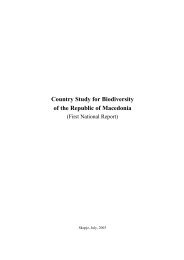CBD Fourth National Report - Azerbaijan (English version)
CBD Fourth National Report - Azerbaijan (English version)
CBD Fourth National Report - Azerbaijan (English version)
Create successful ePaper yourself
Turn your PDF publications into a flip-book with our unique Google optimized e-Paper software.
Country Study on Biodiversity and <strong>Fourth</strong> <strong>National</strong> <strong>Report</strong><br />
The Republic of <strong>Azerbaijan</strong><br />
and commerce. However, the fish catch exceeds official quotas, and in addition a range of<br />
illegal fishing methods are used and fish are illegally hunted during the spawning season. Fish<br />
populations are also affected by other factors such as: lack of regulation of water levels; lack<br />
of fish protection equipment in reservoirs; and pollution. Trade in a number of wild species is<br />
reported from Nakhichevan. These include wild boar, mouflon, mountain goat (bezoar), quail,<br />
venomous snakes, and wild plants such as tulips and orchids.<br />
Water extraction is an important issue in Nakhichevan, given its abundance of water bodies<br />
and underground water sources. The breakdown, inefficiency and leakage from irrigation<br />
systems and reservoirs result in losses of up to 40% of water due to be used for irrigation.<br />
Hunting is widely spread in Nakhichevan and violation of the assigned hunting and fishing<br />
quotas is allowed, plus a number of illegal hunting methods are broadly being used.<br />
Taking off water from water basins and underground water layers is very important for<br />
Nakhichevan. The accidents and unregulated fetching of water from irrigation system and<br />
water reservoirs lead to loss of water to the extent of 40% for irrigation purposes.<br />
1.1.6.3. Pollution<br />
Water pollution<br />
Challenges related to water resources serve as a background for problems on protection of<br />
environment in the region. Demand for countrywide water reserves and protection from<br />
pollution is put forward as a main strategic security action.<br />
As 3/4 part of territories of the country located in lower relief of Kura river basin being the<br />
largest water through-passage, pollution of river in the territories of neighbouring states<br />
causes ecological burden. So that average 350 million m 3 polluted waters are diverted to Kura<br />
river basin from Armenian territory, average 330 million m 3 polluted waters from Georgia<br />
territory. Di<strong>version</strong> of untreated sewages by neighbouring states to Kura river basin adversely<br />
impacts to its hydrochemical process and water quality. As a result of transboundary<br />
pollution, water basins underwent to pollution in any extent, self-regeneration process<br />
disrupted hereof and they became dangerous source while using. During recent studies there<br />
observed sufficiently high density of copper, molibdenum, zinc, phenol and petroleum<br />
derivatives (10 times more than allowable norm/tolerance pollution standard) in river waters<br />
resulted from transboundary pollution .<br />
Usage of river waters which undergone to serious pollution, by 80% of the countrywide<br />
population in potable water supply and agriculture causes a danger for human health.<br />
Probability of infection of people with different diseases is built up due to use of poor potable<br />
waters.<br />
It was determined as a result of recent observations carried out on transit river flows by proper<br />
authorities of the country that majority of incoming transit flows are polluted with ingredients<br />
could cause a number of complications. Phenols and copper compounds take particular place<br />
among such ingredients. So as a result of analyses it was determined that in boundary zones<br />
with Armenia quantity of phenols in Araz river is 8-10 times more than tolerance pollution<br />
standard, copper compounds are 6-8 times more and accordingly the above in Aghstafa river<br />
are 4-9 and 7-11 times more than tolerance pollution standard.<br />
43<br />
2009

















